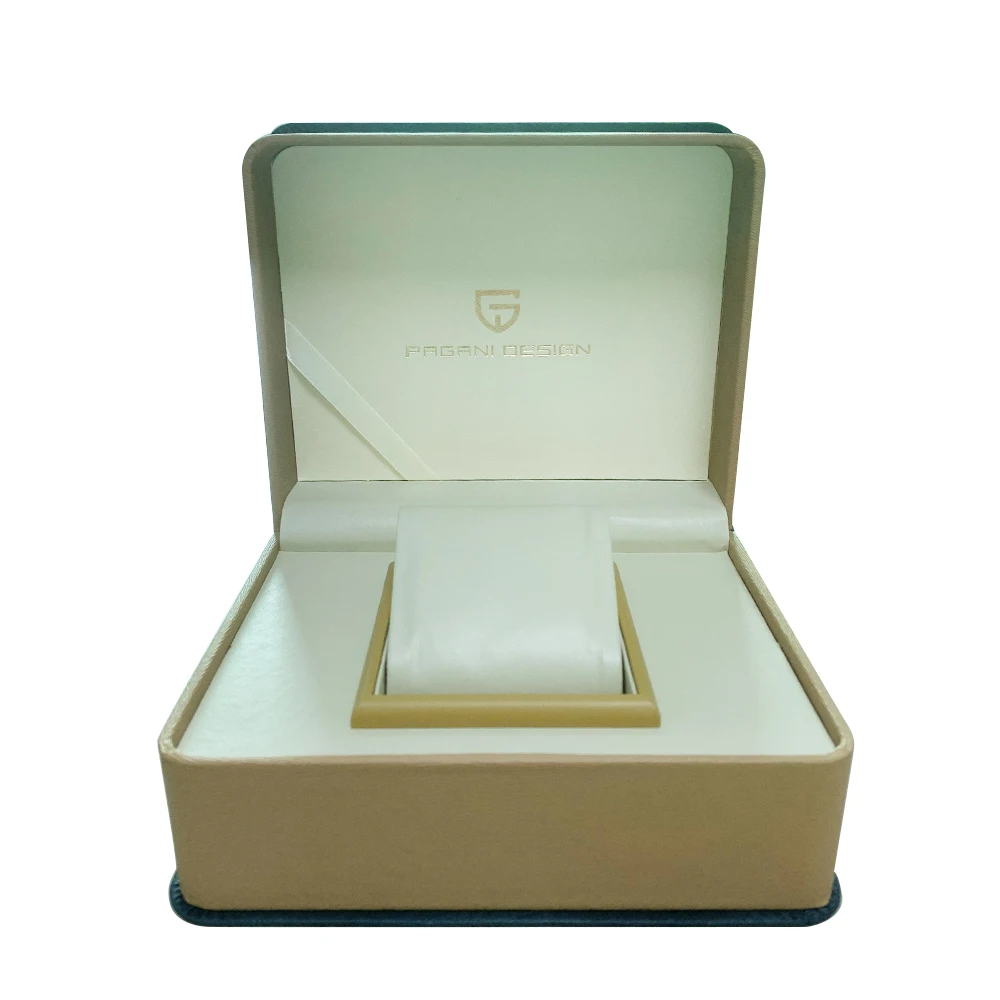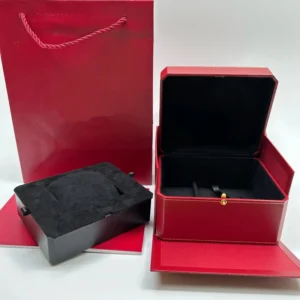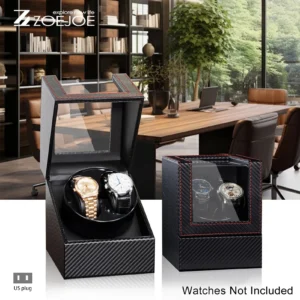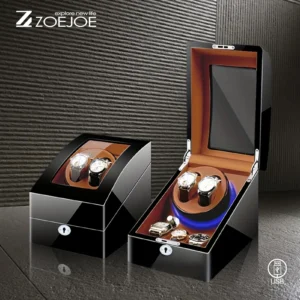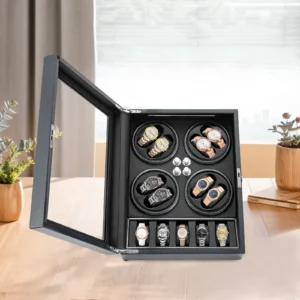Understanding the Natural Aging Process of Leather Watch Boxes
Leather aging in watch boxes refers to the gradual transformation that occurs in the material over time through exposure to environmental factors, handling, and chemical interactions. This process is natural and inevitable, but understanding it can help preserve your valuable storage pieces for years to come.
When discussing leather aging, it’s crucial to distinguish between two very different outcomes:
- Desirable patina: A rich, warm character development that enhances the leather’s appearance, adding depth and personality
- Undesirable deterioration: Breakdown of the material resulting in cracking, flaking, stiffness, or other damage
The quality of leather significantly impacts how it ages. Premium full-grain leathers tend to develop a beautiful patina that collectors often prize, while lower-quality bonded or faux leathers typically deteriorate rather than improve with age. The difference lies in both the material itself and how it’s been treated.
For watch collectors and enthusiasts, this distinction matters tremendously. A well-crafted leather watch box not only protects valuable timepieces but also becomes a cherished item itself, often gaining character with proper caring for leather watch cases techniques that preserve its integrity.
Understanding how different leather watch boxes age helps collectors make informed decisions about their storage investments and maintenance routines. Quality leather doesn’t just last longer—it tells a story through its graceful aging process.
Types of Leather Used in Premium Watch Boxes and Their Aging Characteristics
The type of leather used in watch box construction fundamentally determines how it will age over time. Each variety responds differently to environmental conditions, handling, and the passage of time.
| Leather Type | Characteristics | Aging Profile |
|---|---|---|
| Full-grain | Strongest, most durable, shows natural markings | Develops rich patina, softens slightly, improves with age |
| Top-grain | Sanded surface, more uniform appearance | Good durability, moderate patina development, maintains appearance |
| Genuine leather | Lower layer of hide, often painted or embossed | Limited patina, may crack or peel with age |
| Bonded leather | Leather scraps bound with adhesives | Poor aging profile, typically cracks and peels |
| PU/Faux leather | Synthetic materials mimicking leather | No true patina, often cracks, peels, or deteriorates |
The tanning process significantly influences how leather ages in watch boxes. Vegetable-tanned leathers, produced using natural plant extracts, typically develop more pronounced patinas and respond better to conditioning. In contrast, chrome-tanned leathers (processed with chromium sulfates) maintain more consistent coloration but may be less responsive to conditioning treatments.
Finish types also play a crucial role in the aging process:
- Aniline leather: Minimally finished, showing natural markings and developing the richest patina
- Semi-aniline leather: Light protective coating while preserving natural character
- Pigmented leather: Heavier surface treatment, more uniform appearance but limited patina development
Understanding the differences between wood and leather watch boxes helps collectors appreciate why certain materials might be preferred for specific collections. When considering long-term storage solutions, these material characteristics significantly impact how your investment will look and function years later.
Quality leather watch boxes typically exhibit certain visual indicators: tight, consistent stitching; smooth edges; natural grain patterns; and rich, deep coloration. These features not only enhance initial appearance but also predict how well the piece will develop character with age. Following proper leather watch box maintenance tips specific to your leather type can dramatically extend its useful life.
Environmental Factors Accelerating Leather Aging in Watch Storage
Environmental conditions are perhaps the most significant determinants in how quickly and in what manner leather watch boxes age. Understanding these factors helps collectors create optimal storage conditions for their prized possessions.
Humidity: The Delicate Balance
Leather requires a delicate humidity balance to maintain its integrity:
- Excessive moisture (above 65% relative humidity): Promotes mold growth, discoloration, and can cause leather to warp or develop a musty odor
- Extreme dryness (below 35% relative humidity): Leads to cracking, brittleness, and loss of essential oils
Different home environments present varying humidity challenges:
– Bathrooms: 70-90% (too humid)
– Basements: 60-80% (typically too humid)
– Heated living spaces in winter: 20-30% (too dry)
– Ideal bedroom or office: 40-60% (optimal range)
Temperature Fluctuations and Their Impact
Temperature affects leather at a molecular level, influencing its flexibility, moisture content, and dimensional stability. The ideal temperature range for leather watch box storage is 65-75°F (18-24°C). Rapid temperature changes are particularly damaging, causing leather to expand and contract repeatedly, which breaks down fiber cohesion over time.
Light Exposure: The Silent Destroyer
UV radiation gradually breaks down leather fibers and fades colors. Studies show that leather exposed to direct sunlight can show visible degradation in as little as 3-4 weeks. Even indoor lighting, particularly fluorescent bulbs with higher UV output, can cause cumulative damage over time.
Air Quality Concerns
Pollutants, dust, and poor ventilation compound other environmental factors:
– Airborne pollutants can react with leather’s natural oils
– Dust accumulation absorbs moisture and creates abrasive friction
– Stagnant air promotes mold growth in humid conditions
Proper protection of leather watch cases from moisture requires addressing these environmental factors systematically. Seasonal changes often introduce multiple stressors simultaneously—winter’s dry heating combined with cold windows can create microclimates that are particularly challenging for leather preservation.

Chemical and Material Interactions Contributing to Deterioration
Beyond environmental conditions, chemical interactions significantly impact leather aging in watch boxes. These subtle processes can accelerate deterioration even when environmental factors are controlled.
Human Contact Factors
Our hands transfer natural oils, acids, and moisture to leather surfaces:
- Skin oils can oversaturate leather, making it appear darker and potentially greasy
- Acidic perspiration gradually breaks down leather fibers
- Inconsistent handling creates uneven patina development
- Lotions, perfumes, and hand sanitizers contain chemicals particularly damaging to leather finishes
Cleaning Product Concerns
Many household products contain chemicals that harm leather:
- Alcohol-based cleaners strip essential oils and dry out leather
- Ammonia products break down protective finishes
- Bleach-containing solutions discolor and weaken leather fibers
- High pH cleaners (above 8) disrupt the leather’s acid-mantle balance
Using appropriate cleaning products for leather watch boxes is essential for preventing chemical damage. The pH levels of substances contacting watch boxes significantly impact aging—acidic substances below pH 4 or alkaline substances above pH 9 can cause permanent damage.
Material Interactions
Watch boxes often contain multiple materials that interact with the leather:
- Metal components may corrode and transfer oxides to adjacent leather
- Interior linings can release dyes that migrate to leather surfaces
- Adhesives used in construction may break down over time
- Off-gassing from synthetic materials can react with leather’s natural compounds
These chemical interactions often produce subtle changes initially that compound over time. Features of premium leather watch box construction typically include barriers and buffers between potentially reactive materials to minimize these damaging interactions.
Signs of chemical damage differ from natural aging—watch for unusual discoloration patterns, sticky surfaces, brittle areas, or uncharacteristic odors. Unlike the even, gradual changes of natural patina, chemical damage typically appears as irregular patterns or localized deterioration.
The Visual Evolution: Identifying Different Stages of Leather Aging
Understanding the visual progression of leather aging helps collectors distinguish between normal character development and concerning deterioration. This knowledge allows for timely intervention when needed while appreciating the beauty of natural patina development.
Early Stage Changes (0-2 Years)
During the initial period, quality leather begins its transformation through:
– Subtle color shifts, typically darkening slightly where handling occurs most
– Minor softening of initially stiff areas
– Development of a gentle sheen on frequently touched surfaces
– Slight rounding of sharp edges and corners
These early changes are generally positive signs in quality leather, indicating the beginning of personalization and character development.
Mid-Stage Patina (2-5 Years)
As leather continues to mature:
– Colors deepen and become richer, particularly in areas exposed to light and handling
– Texture becomes increasingly supple and pleasant to touch
– Surface develops more pronounced character marks that tell the story of use
– Subtle variations in sheen create visual depth
This middle phase represents the most desirable aspect of leather aging, where luxury watch boxes develop their unique personality while maintaining full functionality.
Advanced Patina (5+ Years)
Well-maintained quality leather eventually reaches an advanced patina stage:
– Rich, complex coloration with depth that cannot be manufactured
– Buttery-soft texture that feels luxurious to the touch
– Complete character development with unique markings and subtle variations
– A lived-in appearance that suggests heritage and history
Distinguishing Patina from Damage
It’s crucial to differentiate between desirable aging and deterioration:
- Patina signs: Even coloration changes, soft flexibility, surface character that maintains structural integrity
- Damage signs: Cracking (not just creasing), flaking finish, brittle texture, sticky surfaces, uneven discoloration
The timeline for these changes varies dramatically based on leather quality, environmental conditions, and care practices. Premium full-grain leathers might take decades to develop deep patina, while bonded leather products may show deterioration within months of purchase.
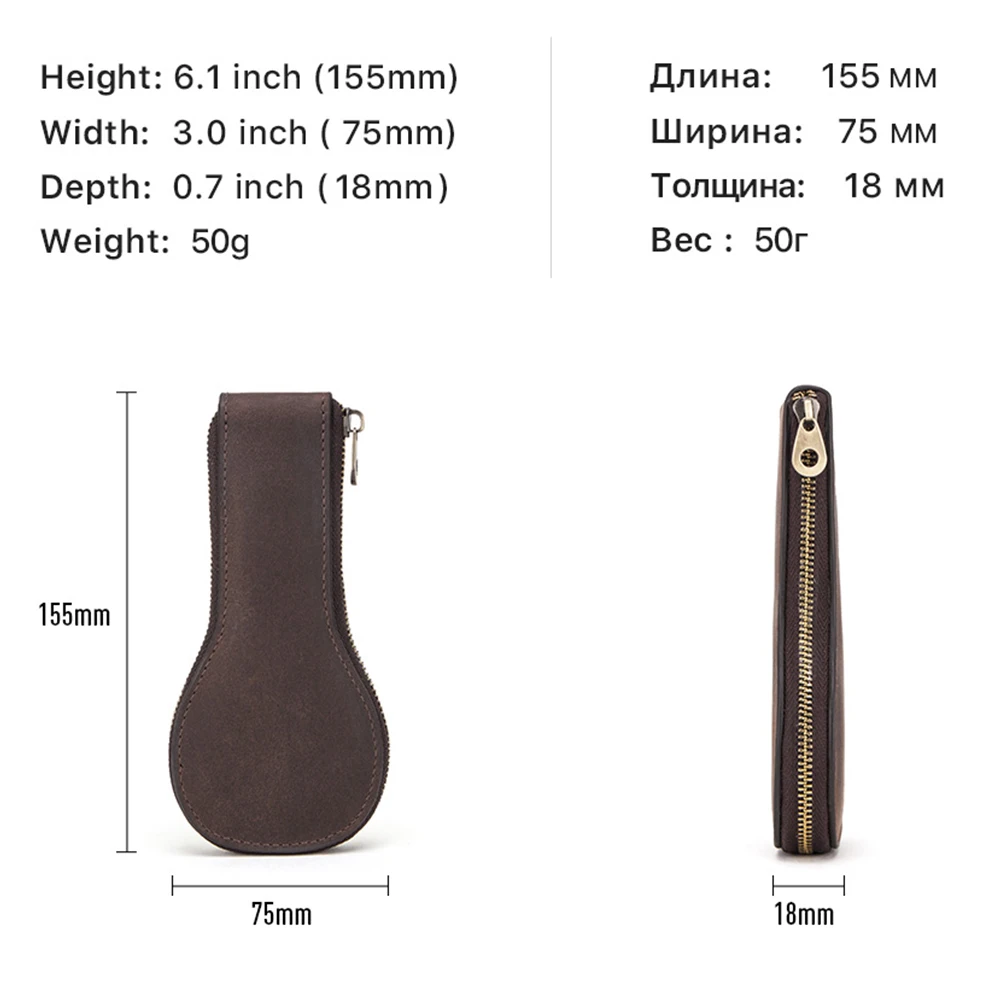
Functional Impact of Aging on Watch Box Performance and Protection
While aesthetic changes are the most obvious signs of leather aging, the functional impacts on a watch box’s performance are equally important considerations. These changes affect how well the box protects and displays your valuable timepieces.
Protective Capability Changes
As leather ages, its protective qualities evolve:
- Leather hardening can reduce shock absorption qualities
- Subtle warping may create gaps in closures, allowing dust entry
- Changes in flexibility can affect how tightly the box closes
- Aged leather may transfer less moisture than new leather, potentially affecting humidity regulation
These changes mean your watch box’s ability to shield timepieces from environmental factors gradually shifts over time, requiring adaptation of storage practices.
Cushioning and Support Evolution
Interior components experience aging effects that impact watch security:
- Cushions gradually compress, potentially allowing more watch movement
- Divider rigidity may decrease, reducing compartment definition
- Watch pillows can lose their shape, affecting how watches sit
- Leather or fabric linings may become compressed or worn in high-contact areas
Closure and Structure Considerations
Functional hardware and structural elements face challenges:
- Hinges may loosen as surrounding leather softens
- Closure mechanisms (magnetic, snap, lock) can become misaligned as leather shrinks or expands
- Weight distribution changes as leather density shifts with aging
- Edge integrity may compromise overall structural stability
Understanding the protective properties of different watch box materials helps collectors assess when aging begins to compromise function. The signs that a watch box is no longer providing adequate protection include:
- Visible light penetration around edges when closed
- Dust accumulation on watches despite storage
- Loose or unstable positioning of watches inside
- Closure mechanisms that no longer align properly
- Visible structural deformation when the box is handled
While beautiful patina enhances visual appeal, collectors must remain attentive to these functional impacts to ensure continued protection for their timepieces. Regular assessment of these aspects helps determine when restoration, repair, or replacement becomes necessary.
Essential Preventive Measures for Extending Leather Watch Box Life
Taking proactive steps to prevent premature aging can significantly extend the useful life of leather watch boxes while promoting positive patina development. The key lies in creating optimal storage conditions and handling practices.
Creating the Ideal Environment
Control these critical environmental factors:
Humidity management: Maintain 40-60% relative humidity
– Use hygrometers to monitor levels
– Consider room humidifiers or dehumidifiers as needed
– Place silica gel packets inside the box in extreme conditionsTemperature stability: Keep temperature between 65-75°F (18-24°C)
– Avoid placement near heating vents, radiators, or cold windows
– Prevent exposure to direct sunlight
– Maintain consistent temperatures without rapid fluctuationsLight protection: Minimize UV exposure
– Store watch boxes away from windows and direct sunlight
– Consider UV-filtering films for room windows
– Keep display lighting at low intensity and duration
Proper Handling Protocols
Establish these handling habits for maximum preservation:
- Clean hands before touching leather surfaces
- Handle with dry hands free of lotions or sanitizers
- Lift from solid structural points, not decorative elements
- Open and close lids gently to prevent strain on hinges
- Support the base when moving to maintain structural alignment
Preservation Tip: When not in active use for watch storage, consider using acid-free tissue to stuff compartments, maintaining their shape and preventing collapse or creasing.
Implementing comprehensive techniques for preserving leather watch storage dramatically extends usable lifespan. Products that help maintain ideal conditions include humidity control systems, leather protectants specifically formulated for fine leathers, and dust covers for periods of extended storage.
Regular maintenance scheduling is essential—establish quarterly assessment routines to check for early signs of environmental damage and address them promptly. This proactive approach helps ensure minor issues don’t develop into significant problems that compromise both appearance and functionality.
Proper Cleaning and Conditioning Techniques for Aged Leather
Regular maintenance is crucial for preserving leather watch boxes, but techniques must be adapted to the leather’s age, type, and condition. Using appropriate methods helps preserve existing character while preventing further deterioration.
Safe Cleaning Approaches
Follow these steps for effective cleaning without damage:
- Dust removal: Begin with a soft, dry microfiber cloth to gently remove surface dust
- Deeper cleaning: For soiled areas, slightly dampen a cloth with distilled water and gently wipe
- Targeted spot cleaning: For specific marks:
– Use a leather-specific cleaner matched to your leather type
– Test in an inconspicuous area first
– Apply with a soft cloth using gentle circular motions
– Avoid excessive moisture that could penetrate seams
Warning: Never use household cleaners, baby wipes, or all-purpose products on leather, as they contain chemicals that damage leather fibers and finishes.
Conditioning for Longevity
Proper conditioning replenishes essential oils and maintains flexibility:
Select an appropriate conditioner:
– Use pH-neutral products specifically for fine leather
– Match the conditioner to your leather type (different formulations for different leathers)
– Avoid silicone-based products that prevent leather from “breathing”Apply using this technique:
– Work in small sections with a soft cloth or applicator sponge
– Use light, circular motions
– Allow full absorption (typically 15-30 minutes)
– Buff gently with a clean cloth to remove excessCondition based on environmental conditions:
– Dry climates: Every 3-4 months
– Average humidity: Every 6 months
– Humid environments: Annually, using lighter application
Learning how to clean leather watch cases properly prevents inadvertent damage during maintenance routines. When conditioning aged leather, use approximately half the amount of product you would on newer leather, as aged leather often has less absorption capacity and can easily become oversaturated.
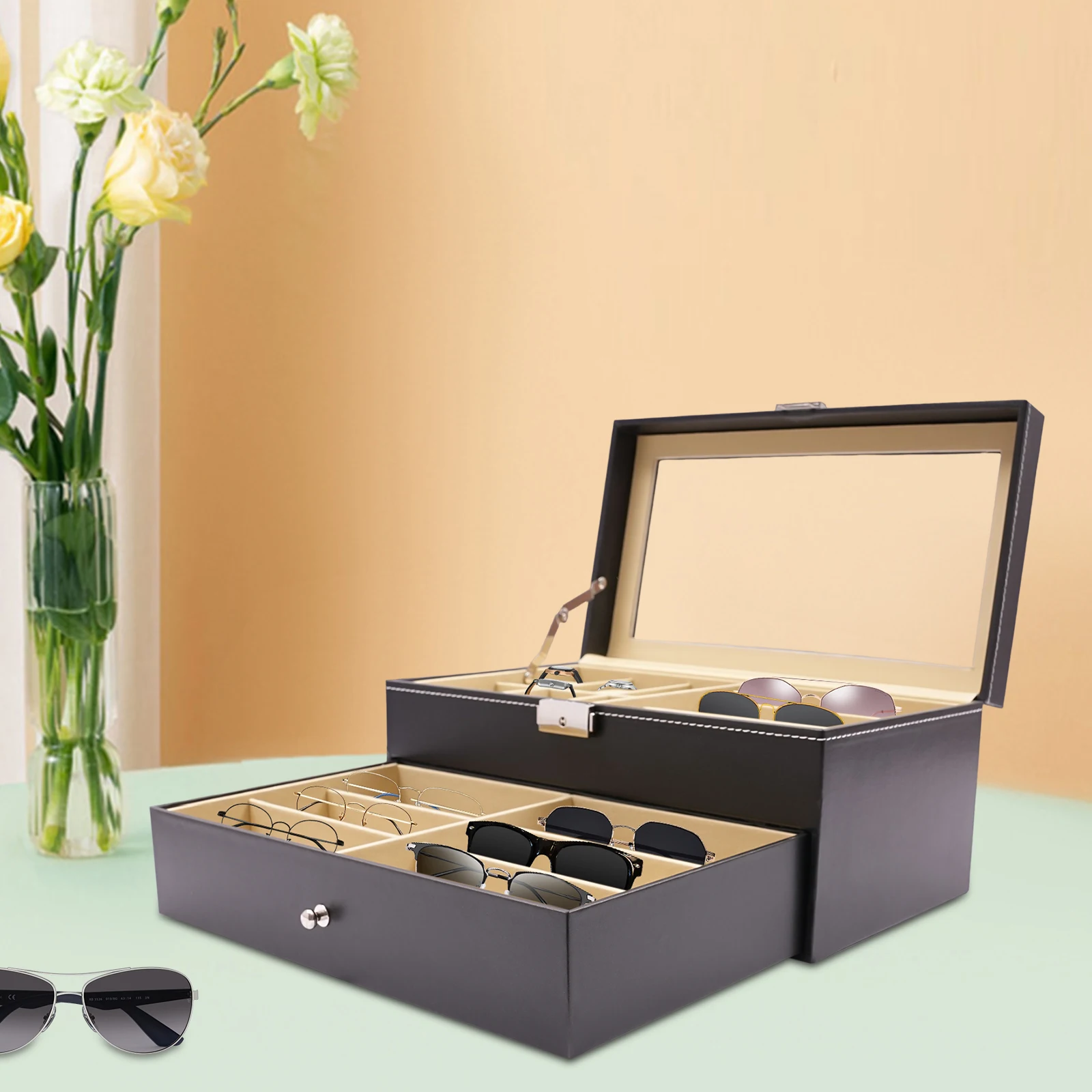
Signs of over-conditioning include a sticky feel, darkened appearance, or greasy residue. If this occurs, gently blot excess product with a clean, dry cloth and allow extended drying time before closing or using the watch box.
Restoration Possibilities for Already Aged or Damaged Watch Boxes
When leather watch boxes show significant aging or damage, restoration may be possible depending on the extent and nature of the deterioration. Understanding restoration options helps collectors make informed decisions about their valuable storage pieces.
Assessing Restoration Potential
Evaluate these factors to determine if restoration is viable:
- Structural integrity: Is the basic structure sound, or has it failed?
- Leather quality: Is the underlying leather still flexible, or has it degraded beyond repair?
- Damage extent: Are issues surface-level or do they penetrate through the leather?
- Material authenticity: Is it genuine leather that can absorb treatments, or synthetic that cannot?
| Restoration Potential Assessment | Good Candidate | Poor Candidate |
|---|---|---|
| Leather flexibility | Bends without cracking | Breaks or crumbles |
| Surface condition | Surface scratches/scuffs | Deep cracks through leather |
| Interior function | Cushions intact or replaceable | Structural failure of dividers |
| Closure function | Hardware functional but loose | Broken mechanisms |
| Value consideration | High-quality or sentimental piece | Low-quality or easily replaceable |
DIY Restoration Techniques
For minor issues, these approaches may yield positive results:
- For dry, cracking leather: Deep conditioning with leather-specific products
- For minor color restoration: Leather-specific dyes or tinted conditioners
- For loose hinges or hardware: Careful tightening or professional replacement
- For compressed cushions: Replacement with compatible watch accessories
- For light scratches: Gentle buffing and conditioning
Professional Restoration Services
Consider professional services when:
– Damage extends beyond surface level
– Structural repairs are needed
– Color matching is critical
– Valuable or antique pieces require expert care
Weighing the costs of professional restoration against replacement is important, especially when considering whether leather watch case repair or replacement makes more sense for your specific situation. Professional restoration typically costs 30-60% of replacement value, making it worthwhile primarily for high-quality or sentimental pieces.
Realistic restoration expectations are essential—while professionals can significantly improve condition, complete restoration to “like-new” appearance is rarely possible. The goal should be functional repair and aesthetic improvement while preserving the character that makes aged leather appealing.
Watch Accessories, Watch Holder
$94.51 Select options This product has multiple variants. The options may be chosen on the product pageLuxury Watch Boxes, Men's Watch Boxes, Single Watch Box
Price range: $903.35 through $980.97 Select options This product has multiple variants. The options may be chosen on the product pageLuxury Watch Boxes, Luxury Watch Travel Case
Price range: $200.33 through $224.57 Select options This product has multiple variants. The options may be chosen on the product pageAutomatic Watch Winder, Double Watch Winder, Leather Watch Boxes
$147.60 Select options This product has multiple variants. The options may be chosen on the product pageAutomatic Watch Winder, Luxury Watch Boxes, Watch Pillows
$294.54 Select options This product has multiple variants. The options may be chosen on the product pageAutomatic Watch Winder, Watch Display Case, Watch Pillows
$718.45 Select options This product has multiple variants. The options may be chosen on the product page
Frequently Asked Questions About Leather Aging in Watch Storage
Is leather aging completely preventable?
Leather aging isn’t completely preventable—it’s a natural process for an organic material. However, it can be significantly managed and directed toward positive patina development rather than deterioration. Proper environmental controls, regular maintenance, and quality materials determine whether aging enhances or degrades your watch box.
Can aged leather transfer harmful substances to watches?
Quality leather that has aged naturally generally won’t transfer harmful substances to watches. However, deteriorating leather—especially lower-quality types—may release dust particles, adhesive compounds, or deteriorated dyes that could potentially affect watch surfaces. This is particularly concerning for watches with porous dials or unprotected case backs. Keeping both the leather and your watches clean minimizes transfer risk.
How often should leather watch boxes be conditioned?
Conditioning frequency depends on environmental conditions and leather type. As a general guideline:
– Dry environments: Every 3-4 months
– Average humidity: Every 6 months
– Humid environments: Annually
Over-conditioning is as problematic as under-conditioning, so always use products sparingly and follow guidelines on whether you should oil leather watch cases.
Does price correlate with aging resistance in leather watch boxes?
While price often correlates with quality materials that age better, it’s not a guarantee. Many mid-priced watch boxes use excellent leathers that age beautifully, while some expensive options may use treated leathers that don’t develop rich patinas. Look for specific leather types and construction details rather than relying solely on price as an indicator.
What’s the average lifespan of a quality leather watch box?
A well-made leather watch box stored in appropriate conditions can last 15-20+ years while maintaining both functionality and aesthetic appeal. Full-grain and top-grain leather boxes typically last significantly longer than those made with genuine or bonded leather, which may begin deteriorating within 2-5 years.
Are vintage leather watch boxes safe for modern timepieces?
Vintage leather watch boxes can be safe for modern watches if they’re properly cleaned, conditioned, and structurally sound. However, older boxes may lack modern protective features like antimagnetic linings or individual watch cushions. Assess the interior materials for potential abrasion risks and consider adding additional protection for valuable modern timepieces.
Selecting Age-Resistant Watch Boxes: Key Features to Consider
When investing in a new leather watch box, certain features significantly impact how well it will resist aging and maintain functionality over time. Making informed choices at purchase can dramatically extend your watch box’s useful life.
Material Selection for Longevity
Look for these quality indicators in leather watch boxes:
- Full-grain or top-grain leather exteriors
- Vegetable-tanned leather for superior patina development
- Even, consistent coloration without artificial surface patterns
- Natural grain visibility rather than heavily corrected surfaces
- Properly finished edges with smooth, sealed borders
Construction Elements That Enhance Durability
Quality construction details contribute significantly to aging resistance:
- Reinforced corners that maintain structural integrity
- Stitching that penetrates completely through joined materials
- Metal hardware with proper anchoring to prevent pulling
- Interior lining attached with minimal adhesives
- Proper weight distribution when fully loaded
Purchasing Tip: Ask about the specific leather type, tanning method, and interior construction materials before investing in a premium watch box. Quality manufacturers readily provide these details.
Interior Considerations
The interior elements should complement exterior durability:
- Cushions with removable/replaceable design
- Non-abrasive materials in watch contact areas
- Dividers firmly anchored to the base structure
- Materials resistant to oils transferred from watches
- Proper clearance for watches of various sizes
For collectors who frequently travel with timepieces, luxury watch travel cases with reinforced exteriors offer additional protection against handling stress and environmental changes.
When examining potential purchases, look for signs of attention to aging-resistant design: properly finished seams, minimal exposed adhesives, consistent material thickness, and hardware appropriately sized for the materials it secures. These details distinguish boxes designed for long-term use from those built primarily for initial appearance.
By selecting watch boxes with these age-resistant features, collectors can ensure their storage solutions mature gracefully alongside their timepiece collections, developing character while maintaining protective functionality.

